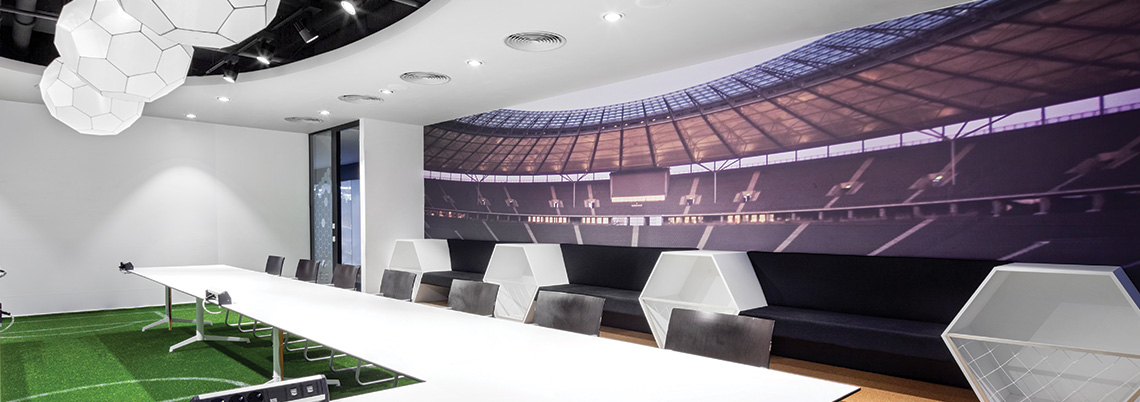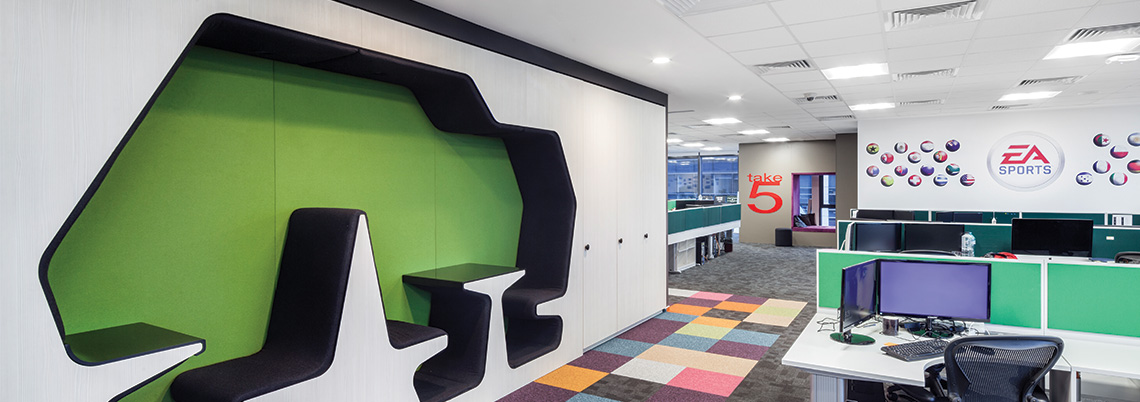EA Games
AFI2 is one of the most acclaimed office buildings in Bucharest, home to EA Games Romania. It is also one of the projects that garnered a lot of positive press coverage from an office design point of view.
Running a global operation with shared services (including IT security) and hundreds of programmers – in double daily shifts to also cover US time zones - cannot be accomplished only by drinking coffee and snacking on sweets. You also need the right light to support their spark and concentration.
And this was Greentek’s task: to provide a LED lighting system that supports its people’s well-being, the EA brand associations, and EA mission: inspire the world to play - while being kind to the environment as well.
The challenge
So how did we do that? In partnership with architect Anda Manu from AMA Design who developed the office design concept, we brought the light to play. We made sure light told a different story on each of the building’s 10 floors. Each floor was designed according to the environment in various EA games from FIFA to Battlefield and NHL.
Greentek’s light designers thus had to imagine how the light would look on a StarWars battleship and create it accordingly.
Or how shiny and energetic a football field would feel. For the Arena, we used Chase track spotlights and Juniper recessed spotlights.
For the open work spaces – we thought programmers and designers had enough noise to program inside their own games, to not tolerate a loud background noise in the office. So we placed recessed Kaypro luminaires with sound-absorption properties, creating a virtual individual workspace for each employee.
And for the amazing reception area – we used outdoor Myriaky luminaires to create an industrial, energetic mood, typical for the EA brand. The industrial feel was also enhanced by a high-bay luminaire, resembling a large reflector lamp – Kaven. Kaven was equipped with colored LEDs – so each one emitted a different color – red, green, blue and so on.
Besides telling stories with light, Greentek also had to cover the more practical aspects of the lighting system specifically project sustainability: while LED technology is by design the most energy-efficient solution compared to all other lighting alternatives, the LED solution can be enhanced by intelligent lighting control systems.
The intelligent lighting system in the EA offices is based on daylight harvesting and hundreds of presence sensors.
Daylight harvesting function -LightOptimal- means adjusting the output of the luminaires based on the quantity of natural light present in the room, to create an energetic yet comfortable space, in tune with our biorhythm. Natural light is the most beneficial type of light for all of us but sadly, we spend 90% of our time indoors – under artificial light. Given the long hours that programmers work, we had to propose a solution that made the most of the natural daylight through sensors and automated controls.
Presence sensors ensured that light was dimmed up or down depending on whether somebody traveled the corridors or entered a meeting room. Basically, you had light walking with you. Which is sort of StarWars-nice, isn’t it?
The results
The solution implemented counts 1,080 LED lighting fixtures, with a total consumption of 38.5 kWh, encompassing:
- 750 troffers of 60x60cm and a total consumption of 30 kWh
- 40 troffers of 30x120cm – total consumption of 1.6 kWh
- 290 downlights – total consumption of 6.96 kWh.
Overall benefits count over 40% less lighting fixtures than any alternative solution based on traditional technologies. Additionally, LED luminaires on their own are 70% more energy efficient, and, when daylight harvesting function -LightOptimal- and PIR sensors are added, the energy savings of the entire building amounts up to 88%.
To these benefits, we could also count the savings coming from zero maintenance work – since LED luminaires have a lifespan of over 50.000h and come with Greentek 5-year „no matter what” guarantee. On the other hand, traditional luminaires have to be serviced, on average, at least once every 2 years.

